Can You Trust Carbon Fibre Frames? (Explained)
Over the last couple of decades, the use of carbon fibre has become more and more popular with bicycle manufacturers. However, there are still many myths and misconceptions about carbon bike frames, so people still ask ‘can you trust carbon fibre frames? Carbon frames have evolved from being an exotic, unreliable material only used on the highest-end endurance bikes, to now being one of the most commonly used materials.
so, are carbon fibre mountain bikes durable?
- When Is Carbon Worth It? (carbon vs. Aluminum)
- How Long Should a Carbon Frame Last?
- How Long Do Carbon Mountain Bike Frames Actually Last?
- Do Carbon Frames Break Easily?
- Do Carbon Bikes Crack?
- Can Carbon Fibre Frames Get Damaged by Heat or Cold?
- How Often Should You Inspect a Carbon Frame for Damage?
- How Do I Know if My Carbon Frame Is Damaged?
- Can a Damaged Carbon Bike Frame Be Repaired?
- How Much Does It Cost to Repair a Carbon Frame?
- Q&A
- What should I use to clean my carbon bike?
- Can you buff a carbon fibre frame?
- What is carbon assembly paste? and should I use it?
- What is a carbon assembly paste alternative?
- Do I need to use a torque wrench on carbon frames?
- Can you trust a cheap unbranded carbon frame?
- What grease is safe for carbon?
- Is WD 40 safe for carbon fibre?
- Should I buy a used carbon mountain bike?
- Final Thoughts (Can You Trust Carbon Fibre Frames?)
When Is Carbon Worth It? (carbon vs. Aluminum)
There are both benefits and negatives to carbon fibre compared to aluminium or steel.
Benefits of Carbon Bike Frames
- Weight: Carbon is normally lighter, making the bike much more agile, and more enjoyable to ride up hills. The reduced weight also makes bikes less tiring when riding downhill as you can move more on the bike, and pick the bike up if needed.
- Tuneable: Carbon is much more “tuneable’ meaning you can control wall thickness at specific points making it stronger and stiffer where needed, and also thinner and more flexible were also needed.
- No Rust: Unlike aluminium or steel frames carbon will not rust.
- Does Not Fatigue: unlike steel or aluminium frames, carbon frames will never fatigue. As long as you don’t crash hard, and keep the frame well maintained, it should theoretically last forever.
- Ride Quality: Ride quality is a subjective feature of carbon frames. Theoretically, as wall thickness is more tuneable then you can tune the bike to be much more comfortable to ride.
- Quiet Ride: One of the first things people notice about carbon fibre bikes is that they are much quieter than their metal counterparts. Although this is a small feature of carbon it does add a much more premium feel to the ride of the bike.
Benefits of Steel/aluminium Bike Frames
- More impact resistant: A big advantage to metal frames compared to carbon frames is that metal frames are much better at taking impacts, although carbon frames are now being reinforced with Kevlar armour to protect in vulnerable areas like around the bottom bracket.
- Cheaper: If you are on a budget then an aluminium or steel frame is, without doubt, a great alternative. At the end of the day, you can have just as much fun on a metal bike and you might be happy knowing it’s less likely to be damaged during an impact.
- Environmental impact of carbon fibre: Have you ever thought about the environmental impact of carbon fibre? Carbon fibre requires a large amount of energy to produce, it’s around 14 times as energy-intensive as producing steel. Also, around 20% of carbon manufacturing is waste. However, carbon fibre is 20% lighter, so it requires less material, and it’s possible to infinitely recycle carbon fibre, unlike steel.

How Long Should a Carbon Frame Last?
The general consensus among the largest bike manufacturers that produce carbon fibre frames and forks, says the average life of carbon is 5 to 7 years if ridden, or 7 to 10 years if left unridden. However, this depends primarily on how the carbon is layered during manufacturing, what resins are used and the process they were used in. and how the frame is used or abused.
However, a good general guideline is that the lighter the carbon frame or component, the less abuse/riding it can tolerate. Lightness is achieved by concentrating the strength in the layers of carbon in the most important/structural areas. So to put simply lighter thinner carbon frames are unlikely to last as long as thicker heavy-duty frames.
How Long Do Carbon Mountain Bike Frames Actually Last?
Carbon frames normally last at least 5 -6 years if riddles regularly. How long your frame with actually last will depend on what type of riding you do (road, MTB, BMX, etc), and also how careful you are with your bike. Modern carbon frames are becoming much more reliable and normally have a more consistent build quality. This is resulting in a longer life expectancy for carbon frames and components. However, the life expectancy of a steel or aluminium frame is 7-10 years – so carbon still has a little catching up to do. However, if carbon fibre is built well, the right resins are used, and it does not sustain any damage, theoretically, a carbon frame could last indefinitely, as it does not corrode or fatigue, unlike metal frames.
Do Carbon Frames Break Easily?
This depends on the carbon frame. If you have gone for a cheap lightweight frame, then it’s quite likely to break easily. However, if you choose a frame from a reputable brand it’s much more likely to be more robust. This is because carbon frames get their strength from good design and a good manufacturing process. The other benefit of buying a carbon frame from a reputable brand is that they will have created many prototypes, and will have most likely corrected any faults.
Do Carbon Bikes Crack?
Carbon bikes are becoming much more reliable, and cracks are becoming much less common. However, carbon bikes do crack. This is often caused by prior damage to the frame, and sometimes manufacturing faults. If you notice a crack in your frame stop riding it, as carbon is well known for failing spectacularly.

Can Carbon Fibre Frames Get Damaged by Heat or Cold?
Both hot and cold temperatures should not cause any problems to carbon fibre frames. Carbon fibre is used in launch/reentry vehicles and also satellites where the temperatures range from superheated to near absolute zero. Resins commonly used in the manufacture of carbon fibre can withstand heat of up to 220F (104.4C). So for everyday riding temperature should not affect the strength of carbon fibre. Just try not to let your bike fall into an active volcano!
How Often Should You Inspect a Carbon Frame for Damage?
It’s important to inspect a carbon bike after most rides for any serious damage or deep scratches. If you have just had a crash, pay extra special attention while inspecting. It is important to regularly inspect for damage because once carbon fibre is damaged it can fail all of a sudden and very dramatically!
How Do I Know if My Carbon Frame Is Damaged?
- Look for scratches – Hunt for scratches, or wear marks. Make sure to check the frame on areas that are under force, like: around the bottom bracket, headset, rear dropouts, etc. Also, check around any brake mounts or pivots.
- The tap trick – If you find any deep scratches or areas of concern. Take a coin and tap gently around the area. A normal sound will be a ‘high pitch’ ticking sound. Listen for any changes in pitch/sound. A broken carbon frame will go from a high-pitched sound to a dull sound. you can also try pushing with your fingers to see if there is any movement or flex.
- If in doubt – The best way to check to see if a carbon frame is cracked or damaged is with an ultrasound scan. This will likely cost about $100 (£60), but this is a small price to pay to avoid the frame-breaking and landing you in the hospital.
Can a Damaged Carbon Bike Frame Be Repaired?
Yes. Pretty much any carbon frame can be repaired, no matter how severe the damage. Carbon fibre is a great material for repairs because it’s very easy to work with, and the repair will often be as strong, if not stronger than the original.
Repairing a damaged carbon fibre bike frame is done by laying new carbon fibre over the damaged area and then epoxying them in the same direction as the original carbon fibre. Although this will often be stronger, there may be a slight weight gain due to the extra material.
How Much Does It Cost to Repair a Carbon Frame?
It’s worth shopping around to find a good and experienced carbon fibre repair shop. A top carbon fibre repair shop will often offer a paint match service, and your frame will come out looking like new.
- A Small Damaged area will cost = $150-250 (1/3 of tube diameter or smaller. Up to about 1 inch in size)
- A Medium Damaged area will cost = $250-350 (greater than 1/3 of the top tube. Up to about 2.5 inches in size)
- A large Damaged area are will cost = $400-450 (damage greater than 6 inches along the tube)
Q&A
What should I use to clean my carbon bike?
You can use soapy water, and a low-pressure hose like you would on any other bike. As with any bike, try to avoid using a pressure washer as it can wash out all the grease from the bearings and push water into places you don’t want it, like your fork seals. Also, especially when cleaning a carbon bike, try to avoid using any aggressive solvents, as they can damage the paint and in some cases even damage the carbon itself.
Can you buff a carbon fibre frame?
Over time carbon fibre frames can lose their shine. This is usually in fact Just the lacquer that has lost its shine. So yes, you can buff, and polish carbon frames to remove swirls and increase shine, and you can even wax and seal them just the same as you would do to your car.
What is carbon assembly paste? and should I use it?
‘Carbon assembly paste‘ or known as ‘Carbon Grease‘, or even ‘friction paste’ is designed to increase friction so you don’t need to over-tighten carbon parts. Friction paste is often used between the seat tube and seat post to prevent it from slipping on carbon bikes. It also serves the purpose of repelling water, however, this isn’t a big issue compared to aluminium or steel bikes as carbon does not corrode.
What is a carbon assembly paste alternative?
Most people say to use carbon past or nothing. However, if you must use an alternative to carbon assembly compound you could try a non-hardening gasket sealant, or some have had success with Clover lapping compound.
Do I need to use a torque wrench on carbon frames?
Yes, yes and yes! It is much more important to use a torque wrench on carbon frames and components because carbon does not flex much before it breaks. A torque wrench is perfect for when working on carbon frames because you can set the correct torque (tightness), so there isn’t any risk of damage. Even top bike mechanics cannot torque bolts to the correct torque without a torque wrench.
Can you trust a cheap unbranded carbon frame?
Buying cheap, often unbranded carbon frames direct from the factory can be a dangerous game. Carbon frames get most of their strength from the frame design and a meticulous manufacturing process. So even if a cheap frame might look good, it’s hard to know how the frame was built, and if the frame was built to stand up to regulations. Also, most top brands have a long process of prototyping and testing before going into production. This process helps them find and resolve any possible frame design defects. Also, bigger brands normally have a good warranty policy, so if you do have a problem they will replace the frame. Whereas getting a warranty frame from a factory outlet might not be possible, or at least will be hard work.
What grease is safe for carbon?
Yes, all grease is safe to use on carbon fibre. This is according to Cervelo’s testing of lubes, grease, oil, solvents, and cleaners on carbon fiber structures.-Lennard.
But which grease should I use on my carbon frame? A high-quality grease like Finish line ceramic grease would be our recommendation.
Is WD 40 safe for carbon fibre?
Yes WD40 is safe to use on carbon fibre. It can be great to disperse water after washing your bike, and it’s also great for giving your bike a beautiful shine.
Should I buy a used carbon mountain bike?
Buying a used carbon bike can be a great option to save money, but there are some pitfalls and things to be aware of before you make your decision on buying a used carbon mountain bike.
- Second-hand bikes don’t usually come with a warranty. This is the same for most brands, whether they are carbon or aluminium, steel, etc. Frame and component warranties are not normally transferable to a new owner. However, some brands may offer a discount on broken second-hand frames and may offer new frames if it’s within a reasonable time period(2-3 years max from new).
- What is the life of a carbon bike? Are old carbon bikes safe? There are many myths out there that carbon bikes do not last as long as aluminium or steel bikes, which is simply not true. Modern-day carbon bikes are in fact becoming more reliable and do not corrode, unlike metal bikes. However, it’s recommended to be careful when buying a second-hand bike that’s older than 6 years unless you have a good idea of its history.
- What should I check when buying a second-hand carbon bike? When buying a second-hand carbon bike it’s important to check for cracks, dents, and scratches, paying attention to areas under stress, like the head tube, bottom bracket, seat tube, rear dropout, and brake mounts. If you notice anything you’re unsure about please refer to (How do I know if my carbon frame is damaged?) in this post.
Final Thoughts (Can You Trust Carbon Fibre Frames?)
Carbon fibre is widely used and trusted by most high-end bike manufacturers. It is now a material that is reliable and durable for most bike-related applications. However, like any material, it does have its limits and the strength of carbon fibre does depend on how well it’s constructed (also like any metal frame). This is why it’s important to use a reliable brand, so you know they have been built correctly.
You may also like:




